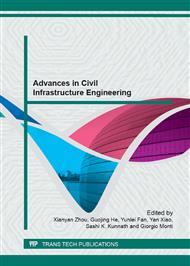p.704
p.708
p.714
p.721
p.727
p.732
p.740
p.745
p.752
Numerical Simulation of Polyurethane Strengthened Perforated Masonry Walls under Blast Loading
Abstract:
In order to investigate the explosion resistance performance of perforated masonry walls strengthened with polyurethane, nine numerical models with different layer number and different strip width of polyurethane are established in this paper. Deformation drawings and time history curves of displacement of the numerical models are comparatively analyzed. It is found that there are two failure modes, global failure and local failure, of strengthened masonry walls and the differences of failure patterns are significant between various types of strengthening method.
Info:
Periodical:
Pages:
727-731
Citation:
Online since:
January 2013
Authors:
Price:
Сopyright:
© 2013 Trans Tech Publications Ltd. All Rights Reserved
Share:
Citation:


